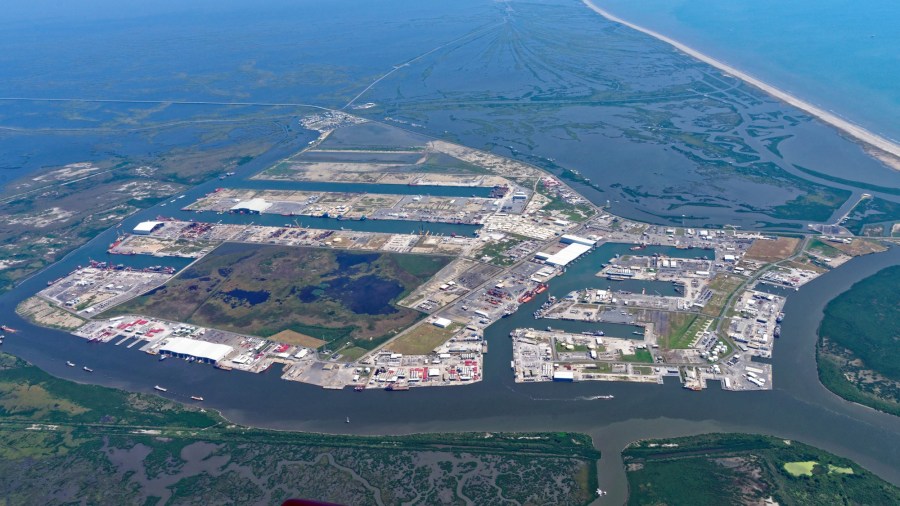When you need to figure out how to deal with water, go to the experts

Justin Ehrenwerth thinks a lot about where to put dirt. “The dirt is gold to us,” he said. “Do you put the dirt here versus here versus there?”
Ehrenwerth leads the Water Institute of the Gulf, a nonprofit research group based in Baton Rouge, Louisiana. And one of the reasons he cares so much about dirt is that Louisiana is losing a lot of it. Water is taking the state’s land because of overdevelopment, sea-level rise and extreme storms. “We’re losing a football field of land every 90 to 100 minutes,” Ehrenwerth said. “We have major challenges down here.”
That means when Ehrenwerth and his team happen upon a mountain of dirt, they use computer models to figure out where the water is coming next so they can use the dirt, and the trees and wetlands planted on top of it, to mitigate future erosion.
Right now, Port Fourchon, at the southernmost tip of Louisiana, is being dredged to accommodate larger ships, displacing tens of millions of cubic yards of dirt, according to Ehrenwerth. “So what we’re doing is we’re using these advanced numerical models to determine where should we put that material — around, in the front, in the back side of the port — to get the biggest bang for the buck,” he said.
The Water Institute uses a number of models to predict the flow of water, including several that were developed in a country used to fighting the waves: the Netherlands. “The oldest government bodies in the Netherlands is not the government itself, but it’s our water boards,” said Dirk-Jan Walstra, who works in coastal engineering for the Dutch nonprofit Deltares. “Our water boards are actually older than the nation itself, just to give you an idea of how long we have been dealing with this situation.”
More than a quarter of the Netherlands is below sea level, and the country is renowned for its anti-flood measures, including dikes, pumps, dunes and algorithms. “We model where the water might go or how big the waves are and how they interact,” Walstra said. “So [if] they attack a dike or a breakwater or something like that, or how rivers flow into the sea, and predict floods and stuff like that.”
From there, the software might look at what will happen to the land from all that water flow, as in Louisiana, or many potential scenarios around the world. About a decade ago, Deltares decided to make its models free to use. They’re sort of an open-source baseline for people in all sorts of situations.
“What we have there in the code is just the rules by which the water should behave. The people at that location that are most often running the model, running simulations. They can play all these what-if games with the models that we provided,” said Robert McCall, a senior researcher with Deltares.
And there are a lot of what-ifs related to climate change. Just last week, President Joe Biden’s administration put together plans to spend billions of dollars to protect against future disasters. Tech will certainly be a part of that.

Related links: More insight from Molly Wood
Here’s some more reading on how the Dutch are influencing the global approach to water management and climate resilience.
Not everyone is convinced that this specific tech transfer is the way to go. A Bloomberg piece from 2018 argues that it’s not, but it took until basically last week for the U.S. to start talking seriously about its own federal response to climate change. That’s when the Biden administration, on Wednesday, to be precise, unleashed a torrent of executive actions that amounted to what the New Yorker called the “most remarkable day in the history of America’s official response to the climate crisis.”
They included clearing red tape for renewable energy, directing the federal government to start buying way more electric vehicles, a focus on environmental justice, and disinvesting in fossil fuel infrastructure, whether related to oil, coal or natural gas. And relevant to our “How We Survive” theme, which is adaptation and resilience, the administration made it clear that investing in prevention, risk assessment and resilience will be a priority.
The future of this podcast starts with you.
Every day, the “Marketplace Tech” team demystifies the digital economy with stories that explore more than just Big Tech. We’re committed to covering topics that matter to you and the world around us, diving deep into how technology intersects with climate change, inequity, and disinformation.
As part of a nonprofit newsroom, we’re counting on listeners like you to keep this public service paywall-free and available to all.
Support “Marketplace Tech” in any amount today and become a partner in our mission.












